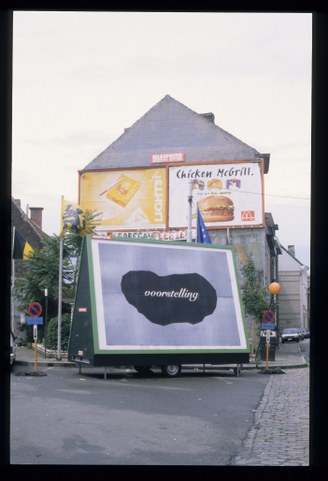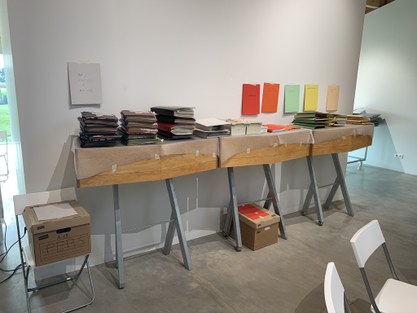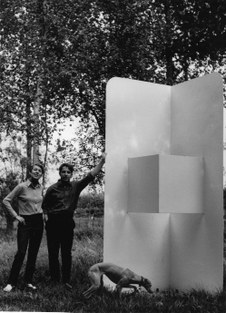Research
The Unexamined/unauthorized Marcel Broodthaers (2024-2025)
IMPETUS
What do we know about Marcel Broodthaers (1924-1976)? Perusing the publications dedicated to this artist, including more than twenty separate museum monographs, the answer would seem to be both a lot and a little. Beyond the well-worn themes of Institutional Critique, word and image, art world role playing, and nationalism, the canonical discourse has scarcely touched on the more indirect aspects of Broodthaers’ oeuvre.
AIMS
In response, the research group KB45 (Art in Belgium since 1945), Ghent University, in collaboration with the Broodthaers Society of America, Princeton University, will organize a two-part conference with new scholarship and artworks that address the more oblique aspects of Marcel Broodthaers' work. Our aim is to encourage fresh insights and uncover new perspectives on his work that expand upon the already impressive depth of scholarship devoted to this great Belgian artist.
If we take a different look at Broodthaers' work there are many examples of latent themes: his use of strict tonal binaries as poetic devices (white and black, light and shadow); his gendered performances of masculinity and reproduction; his faith and lack of faith in art; and his love of slapstick and Les Pieds Nickelés-type comedy. One of the most fertile of these unexamined aspects, however, is Broodthaers' relationship to America, a place he often referenced and even fantasized about, in part because he never set foot on either continent, North or South.
The two-part conference, scheduled for fall 2024, is organized by Stefaan Vervoort and Wouter Davidts of KB45 (Ghent University), and Joe Scanlan, professor at Princeton University and founding director of the Broodthaers Society of America, with the support of their respective institutions.
Art Systems in Latin America. A traveling exhibition from Buenos Aires (2024-2025)
IMPETUS
Art Systems in Latin America is an exhibition of contemporary Latin American art that traveled from Antwerp, Brussels, London, and Paris to Ferrara in the years 1974–75. Fifty years after first arriving in Antwerp, the research group KB45, in collaboration with M HKA, is curating an archive presentation dedicated to this exhibition.
HISTORY
Jorge Glusberg, director of the Centro de Arte y Comunicación (CAyC) in Buenos Aires organized the exhibition in collaboration with Florent Bex, director of the International Cultural Centre (ICC) in Antwerp. Together with the artworks in the exhibition, some twenty Latin American artists traveled to Belgium. For several of them, this relocation marked the beginning of a fascinating journey through Europe during which new encounters and new places would leave a lasting impression on their work.
AIMS
Drawing on a selection of archival documents, the presentation highlights the new forms of mobility introduced by this art in the mid-1970s. Aspects ranging from transportation, migration, portable art (systems) to political mobilization are framed within the broader artistic, institutional, and cultural-political context of the 1960s and 70s.
Kunstsystemen in Latijns-Amerika is on view from May 2024 until January 2025 en is curated by Ine Engels, Elize Mazadiego and Wouter Davidts.
Eight years. Joseph Kosuth in Ghent from 1990 to 1998 (2024)
IMPETUS
Eight Years: Joseph Kosuth in Ghent from 1990 to 1998 - a cross-reference exhibition of information on the presence of an American artist in a Belgian city - results from the research conducted in the framework of a Bachelor and Master thesis in Art Science by Gertjan Oskar, under the supervision of Prof. Wouter Davidts. The research took place within the context of the research group KB45 (Art in Belgium since 1945) on domestic and foreign protagonists within the post-war field of contemporary art in Belgium.
HISTORY
In 1990, American artist Joseph Kosuth, pioneer of conceptual art, settles in Belgium. After several artistic passages in the city in the 1970s and 1980s, he moves both his studio and household from the New York metropolis to manor house in the Maagdestraat in Ghent. Together with his wife, art historian and curator Cornelia Lauf, and later their two children, he continues to live there until 1998.
AIMS
The exhibition Eight Years: Joseph Kosuth in Ghent from 1980 to 1998 presents traces of Kosuth's presence and activities in Ghent before, during and after his stay in Ghent. Using an extensive selection of historical documents, photographs, press, publications, books, works of art and letters from both private and institutional archives, the exhibition sheds light on the forcefield between the international artworld and a specific locality on the one hand, and the private life and public work of an artist on the other. The exhibition shows that a contemporary art practice always develops in a complex network of international contacts and local players, but also always involves a social dynamic between artist and partner, family, colleagues and friends.
De tentoonstelling is on view from Februari until April 2024 in VANDENHOVE en is curated by Gertjan Oskar en Wouter Davidts.
Space for Philippe Van Snick (2023-2024)
IMPETUS
The project 'Space for Philippe Van Snick. Physical and Digital Space for the Conservation and Public Disclosure of the archives of Philippe Van Snick (1968-1990)' is a pilot project of Legacies, Art and Heritage.
With the prospect of the donation of the archives of the artist to the Ghent University Library, the vzw Archief Philippe Van Snick sets out an exemplary trajectory for the transition of the artist's archives from private ownership towards public disclosure, in collaboration with the research group KB45 (Art in Belgium since sinds 1945), Boekentoren, GhentCDH (Ghent Center for Digital Humanities) en het CKV (Centrum voor Kunstarchieven).
AIMS
The project aims to transform parts of the artist’s archive from the period 1968–1990 into a digital working environment within the Estate Philippe Van Snick. This involves the appraisal, selection, inventorying, and digitization of relevant materials. The physical archive will be donated to the University Library. With this initiative, the project partners also seek to develop a protocol for archive transfer and to share this best practice with the wider sector. The project will be completed on 31 August 2024.
Opting for Art. Three contemporary visual art exhibitions during Antwerp 93, European Capital of Culture (2023-2024)
IMPETUS
In October 2023, the archive presentation Opting for Art. Three contemporary visual art exhibitions during Antwerp 93, European Capital of Culture, curated by the research group KB45 opens at M HKA. The archive presentation at M HKA is dedicated to three exhibitions of contemporary art that made up the main Visual Arts programme of the project Antwerp 93, European Capital of Culture.
HISTORY
Under the direction of Bart Cassiman (°1961), three exhibitions were organized during the project Antwerp 93, European Capital of Culture - at the Middelheim (New Sculptures), the Royal Museum of Fine Arts (The Sublime Void. On the Memory of the Imagination) and the MUHKA (On Taking a Normal Situation and Retranslating it into Overlapping and Multiple Readings of Conditions Past and Present).
OPZET
Three decades later, Opting for Art looks back at the role, place and significance of these three exhibitions within the Antwerp 93 project with documents from both public and private archives.
Ruim dertig jaar na datum blikt Kiezen voor kunst aan de hand van documenten uit publieke en private archieven terug op de rol, plaats en betekenis van deze drie tentoonstellingen binnen het project Antwerpen 93. As part of the exhibition, the research group KB45 is organizing the symposium Dossier Antwerp 93 at the end of October 2023, in collaboration with the Centre for Urban History at the University of Antwerp (Prof. Ilja Van Damme) and with the support of Ghent University (Faculty of Arts and Philosophy), M HKA, De Cinema, and the City Archive/FelixArchief.
Kiezen voor kunst is on view from October 2023 until May 2024 and is curated by Eléa De Winter and Wouter Davidts.
The Collection Zonnelied: Preparatory Study for a Display and Storage Space (2022)
IMPETUS
VZW Zonnelied, a service center for persons with disabilities, has housed in its facilities creative studios for residents and daycare workers for several decades. In addition to building its own collection of the visual work produced there, vzw Zonnelied also regularly organizes exhibitions of that collection. For example, on the occasion of its 40th anniversary in 2021, a retrospective exhibition was organized in Community Center De Markten in Brussels. Work from Zonnelied's collection is regularly exhibited in museums at home and abroad and is included in private collections.
In order to visibly anchor the functioning and output of the creative studios within the operation of Zonnelied asbl, the service center has expressed the ambition to set up a place where its own collection can be permanently displayed and preserved.
AIMS
Commissioned by vzw Zonnelied, the research group KB45 (Art in Belgium since 1945) made a study of a display and storage place for Zonnelied's art collection. The study maps out institutions in Flanders and the wider international environment, looking at both places that focus specifically on visual work by people with disabilities and places where it is already featured (or not).
The study was completed in 2022. The document provided the basis for consolidating the artistic workings within vzw Zonnelied. On Sunday, March 17, the first stone of the Kunstwerkplek De Loods will be officially laid on the campus 't Zinneke in Brussels.
50 years Frans Masereel Centre (2022)
IMPETUS
In 2022 the Frans Masereel Centre in Kasterlee celebrates 50 years of existence. The institution seizes the jubilee as an opportunity to write the history of the Centre, resulting in a publication, exhibition and/or website.
The research group KB45 has been appointed by the Flemish Community to write the history of the centre in preparation of the festivities in 2022.
HISTORY
The origins of the Centre lie in a collection of old printing presses belonging to the graphic artist Fons Mertens. To house them, he commissioned architect Lou Jansen in the early 1970s to design a studio for intaglio, relief printing, screen printing, and lithography. In 1972, the building was purchased by the Belgian State under the initiative of then-Minister of Culture Frans Van Mechelen. The new Centre was named after the renowned graphic artist and woodcut printmaker Frans Masereel, who passed away that same year. Additional studios were also constructed so that, alongside functioning as a workshop and exhibition space, the Centre could also serve as a residency.
Today, the Frans Masereel Centre positions itself as 'a place of creation, but also a platform for knowledge exchange, international collaboration, and research.' Each year, around sixty (inter)national artists stay in Kasterlee for periods of three to six weeks, where they can make use of the printmaking workshop and exhibition space.
Over the years, the Frans Masereel Centre has built up a significant print collection and archive. Since its founding in 1972, every artist has donated a work of art following their residency at the Centre.
In spring 2019, the Frans Masereel Centre opened a new wing, designed by Japanese architect Hideyuki Nakayama in collaboration with Ido Avissar of the Paris-based firm LIST. This new building houses the digital studio, the collection, and a project space.
ARCHIVE
The Frans Masereel Centre holds an extensive archive (clipping folders, correspondence, and administrative documents). In addition, the Centre also possesses a rich collection of printed materials. An inventory and study of the Centre’s archive makes it possible to sketch a detailed portrait of an institution that is both locally and internationally unique.
IMPETUS
The research project on the history of the Frans Masereel Centre has multiple objectives:
- cultural policy: The Frans Masereel Centre is located in a peripheral region—the Kempen, near Turnhout. Although it began as a local initiative, it was officially established as a national centre in 1972 by the Minister of Culture, Frans Van Mechelen, who himself came from the Kempen (Turnhout). The Centre’s history offers insight into the art and cultural policy in Belgium and Flanders over the past 50 years, as well as the tensions between local, provincial, regional, and national cultural politics.
- artistic: Over the years, the Frans Masereel Centre has hosted nearly every Belgian artist working with graphic and printmaking techniques (from Marcel Broodthaers, Roger Raveel, and Jef Geys to lesser-known artists), as well as many international artists. The Centre’s roster provides a unique lens through which to study the development of the graphic arts in Belgium.
Plus-Kern gallery (2020-2024)
IMPETUS
In 2020, Jenny Van Driessche donated the archive of Galerie Plus-Kern (including exhibition history, artist correspondence, press clippings, and administrative documents) to the Ghent University Library.
In collaboration with the library’s staff, the research group KB45 is making this archive accessible through inventorying, digitization, and scholarly study. The project examines the roles and activities of both Jenny Van Driessche and Yves De Smet, and places the artists involved and the exhibition policy of the Plus-Kern gallery within both a local and international context.
HISTORY
Galerie Plus-Kern, an initiative launched by artist Yves De Smet and his wife Jenny Van Driessche, opened its doors in the spring of 1969. The "center for constructive design" — as the couple dubbed their gallery — was located in a townhouse at Gebroeders Vandeveldestraat 16 in Ghent. Plus-Kern included a design shop, a printmaking department, and several exhibition spaces that hosted both Belgian and international artists. Initially, De Smet and Van Driessche focused on geometric abstraction and kinetic art, before moving toward a more conceptual approach. Key figures in the early period included François Morellet, Jan Schoonhoven, Amédée Cortier, Leo Copers, and Raoul De Keyser. Exhibitions were held not only in Ghent but also in other cities and towns across Flanders. Van Driessche even organized a ‘one day show’ at her country estate in Zaffelare. The gallery's program and broader art developments were documented in Plus-Nieuws, a magazine compiled by Yves De Smet, which ran for eighteen issues from September 1969 to January 1972.
In 1972, Yves De Smet withdrew from Plus-Kern, and the program was from then on curated solely by Jenny Van Driessche. In 1973, she opened a small exhibition space in Galerie Le Bailli, a shopping mall near Avenue Louise in Brussels, where several gallerists collaborated under the impetus of Fernand Spillemaeckers. A year later, Van Driessche closed the gallery. The final exhibitions at Plus-Kern featured artists such as Amédée Cortier, Yves De Smet, Leo Copers, François Morellet, and an anonymous artist.
In 1983, Van Driessche purchased and renovated a townhouse on Vandernootstraat 66 in Brussels. There, she developed another ambitious program, partly with artists she had worked with between 1969 and 1974, and partly with new collaborators. She organized exhibitions of established artists such as Carl Andre, Carel Visser, and Leo Copers, as well as emerging talents like Wim Delvoye, Richard Venlet, and Carlo Mistiaen.
Plus-Kern came to a definitive close in 1992.





